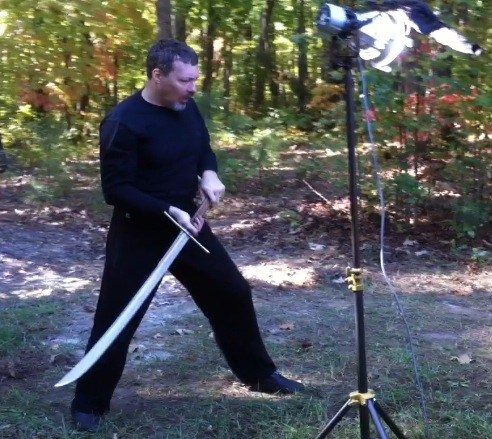 Secrets
of the Viking Sword Secrets
of the Viking Sword
Filming for
PBS Nova documentary, October,
2011
by John
Clements
ARMA
Director
A two-day shoot here at my Iron Door
Studio facility for Secrets of the Viking Sword from
the prestigious PBS science documentary
series, Nova, was exhausting fun. It was a
lot of hard work but a really good experience. As with previous National
Geographic projects, I can say we did some truly
unprecedented things (including a number of
interesting test-cutting experiments and
comparisons of different swords plus some
unique fight demos).
A six-person crew from Pangloss Films in NYC
arrived with a heavy schedule of shots to
prep for. We
shot from 8am to 8pm on Saturday and 9am to
7pm on Sunday and they were really easy going and a
blast to work with. I spent more than a week
readying the facility and property here. We
had a great deal of fine arms and armor
graciously provided by Albion swords and CAS
Hanwei on hand, with a few regional ARMA
members supporting. This was
my sixth professional media project and
although it gets easier each time, it really
is demanding work. It all went
spectacularly well, to my surprise. From what we saw, and
were told, and by what we managed to capture
on camera ourselves, the final product is
going to make really good television.
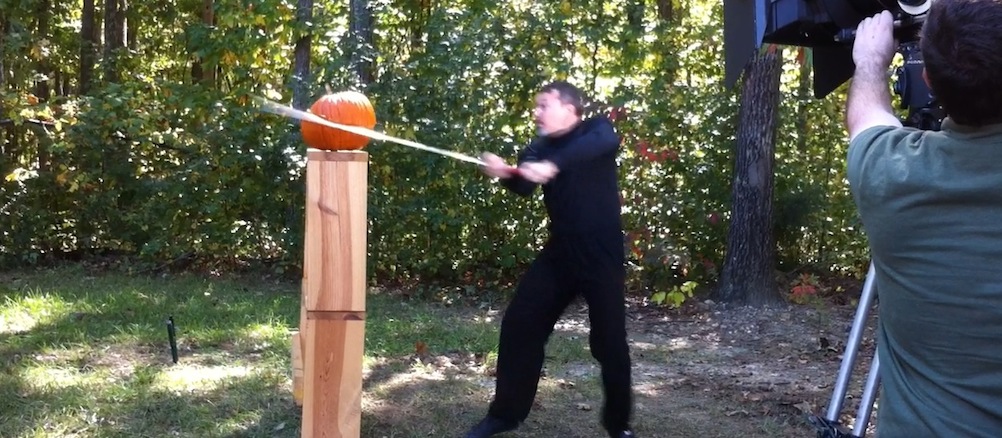 At
award-winning director Peter Yost's request, I used a wide
variety of swords to cut on a diverse range of materials and
targets. Some of these were purposely chosen because they
were cliches, have been over done, or else are misleading
as to what real sword function is all about. We didn't want
the usual demos using cheap soft steel blades with extra-sharp
edges that seem impressive even though they would not stand
up to the rigors of use in actual combat. Real swords were
designed to penetrate meat and bone, deal with the hard and
soft armors protecting them, as well as oppose the other weapons
they would be resisting. Anything else has nothing to do with
their function. It's that simple. At
award-winning director Peter Yost's request, I used a wide
variety of swords to cut on a diverse range of materials and
targets. Some of these were purposely chosen because they
were cliches, have been over done, or else are misleading
as to what real sword function is all about. We didn't want
the usual demos using cheap soft steel blades with extra-sharp
edges that seem impressive even though they would not stand
up to the rigors of use in actual combat. Real swords were
designed to penetrate meat and bone, deal with the hard and
soft armors protecting them, as well as oppose the other weapons
they would be resisting. Anything else has nothing to do with
their function. It's that simple.
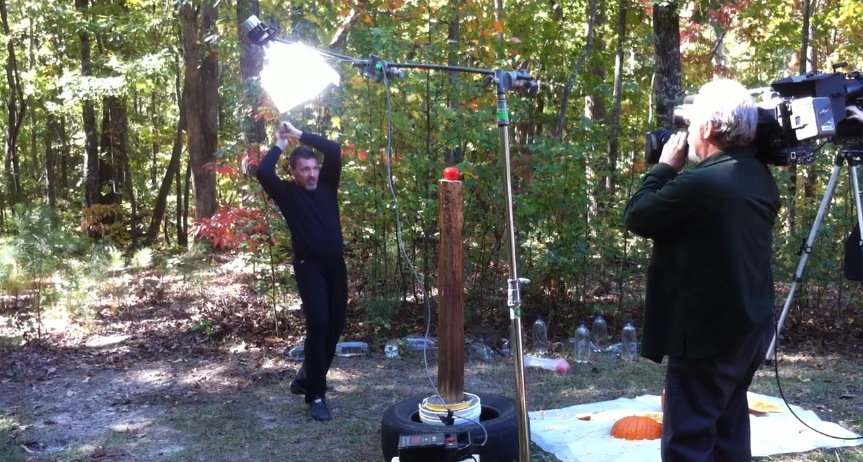 The
fact is, many modern materials and objects won't really be
“cut” when struck with a quality blade honed to
a fine historical edge intended to hold up to the demands
of real fighting. They will be profoundly damaged of course,
but this is less visually impressively to the camera. So,
instead, it's the "feats" performed with blades that have
been given a fragile "stunt cutting edge" that typically impress.
(As I've often said, I know what kind of edge I would want
on a sword in real combat, and it wouldn't be one that's been
“tested” on phone-books, soda jugs, tomatoes,
pumpkins, straw mats, etc. ...you know, all the usual things
likely to have been encountered on the battlefields of history.) The
fact is, many modern materials and objects won't really be
“cut” when struck with a quality blade honed to
a fine historical edge intended to hold up to the demands
of real fighting. They will be profoundly damaged of course,
but this is less visually impressively to the camera. So,
instead, it's the "feats" performed with blades that have
been given a fragile "stunt cutting edge" that typically impress.
(As I've often said, I know what kind of edge I would want
on a sword in real combat, and it wouldn't be one that's been
“tested” on phone-books, soda jugs, tomatoes,
pumpkins, straw mats, etc. ...you know, all the usual things
likely to have been encountered on the battlefields of history.)
The assorted Viking-era swords from Albion
that we used performed superbly. They were
fast and robust and maneuverable to the
point of astonishment. And after hitting full force against maile
armor and helms their tips and edges were merely
grazed with mild scratches. Several larger Albions proved as
agile and versatile as expected in cutting
assorted targets. The quality of the Hanwei
helm, gambeson, and maile armor also exceed
expectations and both held up to what I
would estimate to be historical levels. The
Hanwei Viking swords also proved
surprisingly tough and flexible. There were
no problems in their performance. Their
resilience was most reassuring. The points
of both makes managed to pierce a piece of
historical reproduction Dark Age maile
(crafted by armorer, Parker Brown) as well as puncture the gambeson below and foam padding
beneath (!).
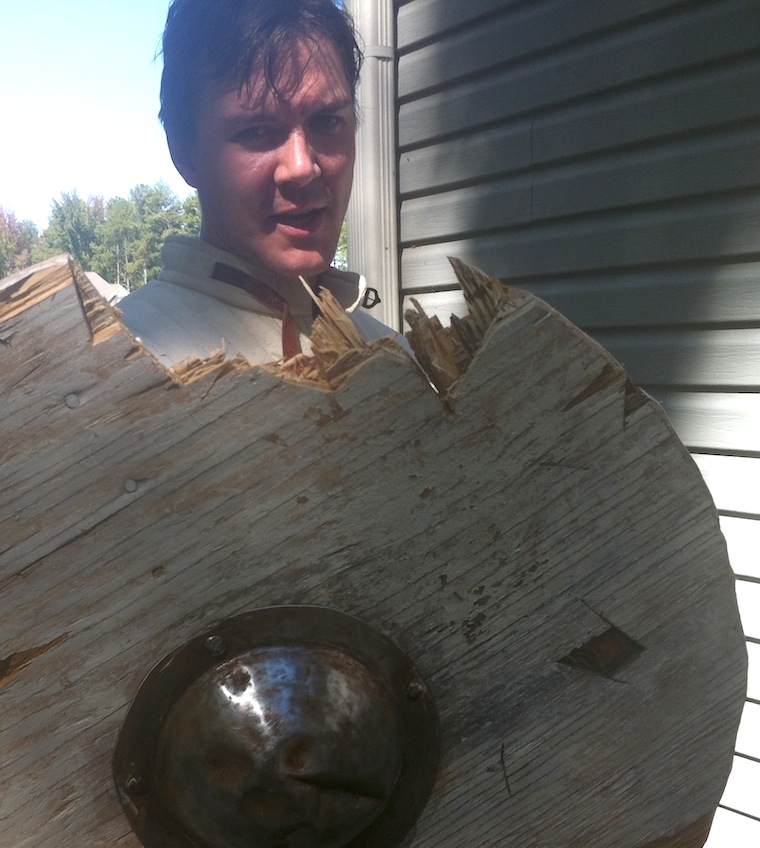 Against
a heavy Viking-era shield reproduction, a Hanwei Viking blade
cut right into the metal rim and bounced off the wood dealing
good cuts but otherwise not overcoming the shield's inherent
sturdiness. Shields worked for a reason, after all. Yet, following
some 40 full-on blows the blades still showed only scratches.
Against a lighter un-rimmed shield, a Hanwei sword chewed
it to pieces. Fellow student Cain Maxwell, suitably protected,
graciously endured holding the shields for struck upon. Against
a heavy Viking-era shield reproduction, a Hanwei Viking blade
cut right into the metal rim and bounced off the wood dealing
good cuts but otherwise not overcoming the shield's inherent
sturdiness. Shields worked for a reason, after all. Yet, following
some 40 full-on blows the blades still showed only scratches.
Against a lighter un-rimmed shield, a Hanwei sword chewed
it to pieces. Fellow student Cain Maxwell, suitably protected,
graciously endured holding the shields for struck upon.
On a conical
Dark Age helm, one Albion Viking blade dented
it to a depth of approximately five
millimeters and, while never actually
cutting into it, left significant edge marks
on both the helm's side plates and its thicker
bands. Impressively, despite a dozen blows
on the helm, the sword edges suffered no
significant effects except on one tell-tale
spot where it connected on a thick rivet.
After this test, I could not help but
imagine it conceivable that a larger,
stronger, fighter hitting against a moving
target could indeed cleave into such a helm
(all the more so if he were using a
double-hand blade, I'm now sure). The helm had been placed
at a realistic height on a semi-mobile
target mannequin that provided some realistic "give." Afterward, by trying
on the helm, armorer, Parker Brown, noted
that the dents did not actually extend to a
depth that would have reached a combatant's head
underneath.
At one point, I was pleased that we managed
to include an effective demonstration of a
fine Hanwei katana cutting straw matts
followed up by me immediately repeating the
test with an old trustworthy and completely
blunt Raven bastard sword. The
effect of cutting with the blunt warsword
was to underscore that edge sharpness is not
all that matters and any well-honed thin
metal blade can deliver very dangerous
blows. I wanted very much to also show for
the program the same comparison upon bamboo
and the cloth gambeson as well as the riveted maile, but
time constraints prevented it. (Of course, I
conducted the experiments sometime later,
along with some additional ones and the outcome was very interesting...)
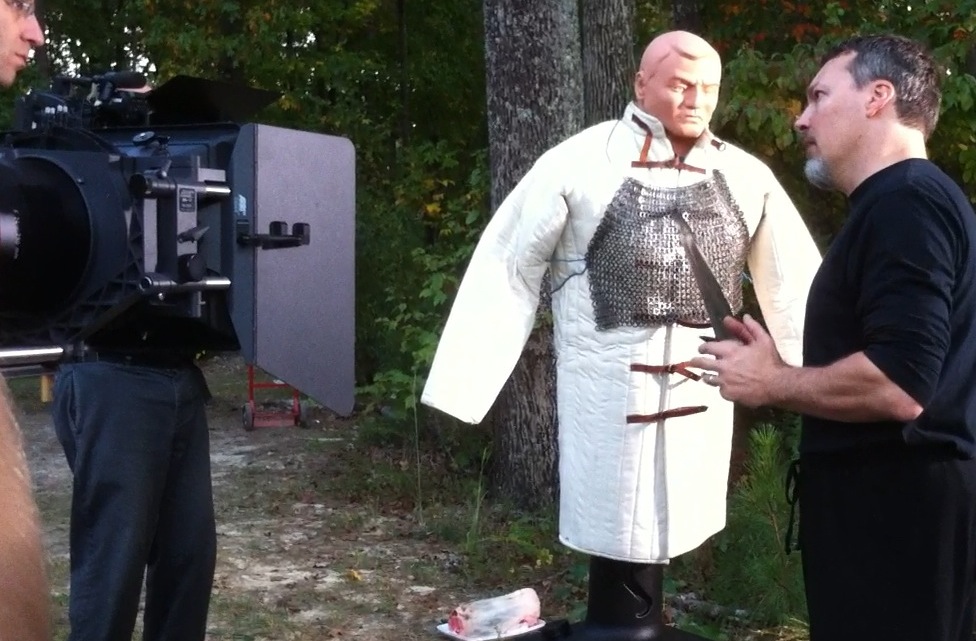 For
a maile and gambeson test a MMA mannequin was used to keep
the target at the right height and angle while giving it realistic
mass and resistance but still allowing for some natural "give."
(This is something I have come to stress in cutting experiments
and am now very critical of test-cutting demonstrations that
blatantly overlook it.) First, an earlier style spatha blade
was used on the maile to show how a thinner sword with a rounded
tip was not well-suited to penetrating the armor. In contrast,
a slightly heavier and thicker Albion Viking blade with its
more acute point proved effective in thrusting. Finally, a
later Medieval blade with a thicker and more tapered profile
revealed its expected advantage. An Ulfbert replica specimen
as well as bare blade pieces forged by both bloomery and crucible
steel processes were also on hand to use. But all proved impractical
for the experiments and visuals the director was looking for.
(We were prevented from trying them by their complete lack
of any hilts, not to mention the restrictive conditions placed
upon any reasonable experiment.) For
a maile and gambeson test a MMA mannequin was used to keep
the target at the right height and angle while giving it realistic
mass and resistance but still allowing for some natural "give."
(This is something I have come to stress in cutting experiments
and am now very critical of test-cutting demonstrations that
blatantly overlook it.) First, an earlier style spatha blade
was used on the maile to show how a thinner sword with a rounded
tip was not well-suited to penetrating the armor. In contrast,
a slightly heavier and thicker Albion Viking blade with its
more acute point proved effective in thrusting. Finally, a
later Medieval blade with a thicker and more tapered profile
revealed its expected advantage. An Ulfbert replica specimen
as well as bare blade pieces forged by both bloomery and crucible
steel processes were also on hand to use. But all proved impractical
for the experiments and visuals the director was looking for.
(We were prevented from trying them by their complete lack
of any hilts, not to mention the restrictive conditions placed
upon any reasonable experiment.)
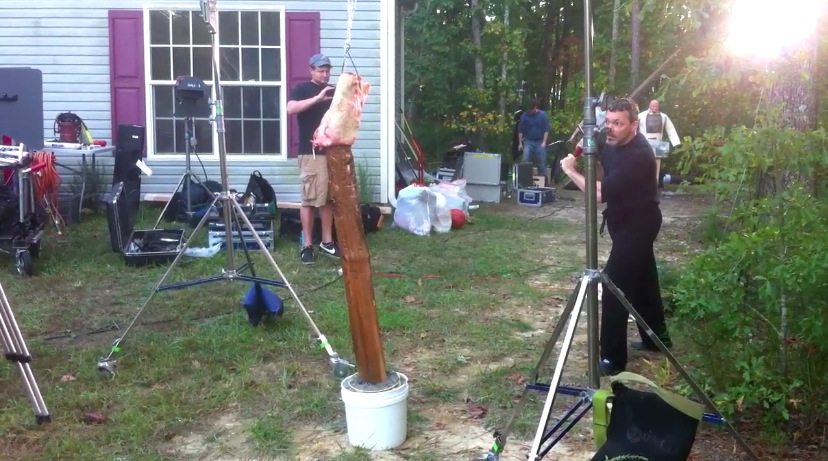 In
one demonstration for the program a large fresh hunk of raw
beef shank was hung from a chain while resting in place at
head level on a low pell. A solid diagonal cut from a longsword
cleaved a ferocious four-inch gash through the heaviest part
of the bone before the target was knocked aside by the impact.
Not as satisfying as I would have liked but an effective demonstration
nonetheless. The next test was on the same shank turned over
and placed sitting atop the pell at head level once more.
A single vertical cut split it in two. Again, a good example
of the devastatingly gruesome force of swords, but I thought
more could have been shown. Unfortunately, the director was
satisfied and we had to move on to complete other scheduled
shots. Only one of the longswords we used suffered significant
(and unexpected) edge-trauma on cutting through one thick
raw beef bone. In
one demonstration for the program a large fresh hunk of raw
beef shank was hung from a chain while resting in place at
head level on a low pell. A solid diagonal cut from a longsword
cleaved a ferocious four-inch gash through the heaviest part
of the bone before the target was knocked aside by the impact.
Not as satisfying as I would have liked but an effective demonstration
nonetheless. The next test was on the same shank turned over
and placed sitting atop the pell at head level once more.
A single vertical cut split it in two. Again, a good example
of the devastatingly gruesome force of swords, but I thought
more could have been shown. Unfortunately, the director was
satisfied and we had to move on to complete other scheduled
shots. Only one of the longswords we used suffered significant
(and unexpected) edge-trauma on cutting through one thick
raw beef bone.
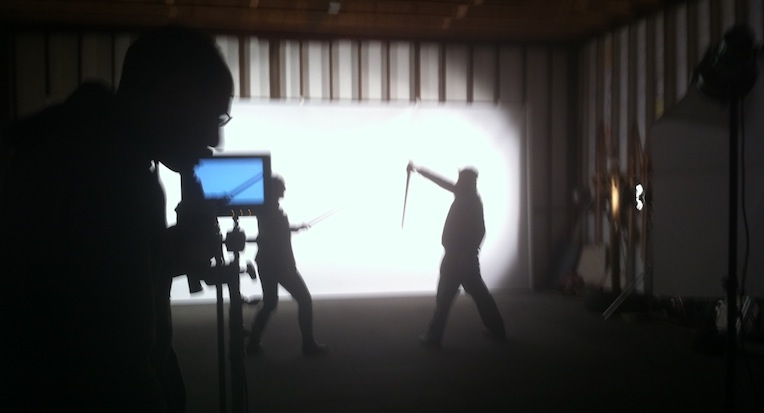 For
putting together some brief combat sequences (and yes,
even a little staged stunt work), we relied on my original
"SAFE method" (Spontaneous Arranged Fighting Examples
TM)
that emphasizes physically intense bio-mechanics with
historically-sound martial techniques. Only briefly did
we have concern for safety and historical accuracy during
the shoot when Peter, the director, wanted a us to execute
a few moves that I had to override. The compromise alternative
we found allowed my young free-scholar, Joey Marmorato,
and I to utilize an energetic exchange of set-plays that
met Peter's needs while happily maintaining the integrity
of both our crafts.
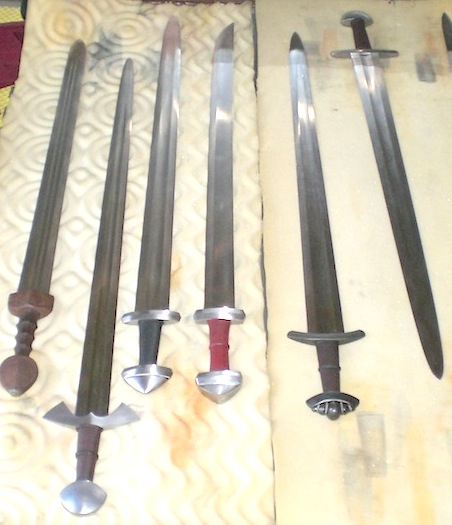 Toward
the end of the second day's shoot, we did some pretty wild
visuals using moving silhouettes. The cinematographer arranged
an incredible effect that allowed us to show various swords
forms in profile as well as how a few of them handled in fighting.
I think the end result will be quite striking. I believe the
sequence is unprecedented in a television program. Lastly,
Joey and I conducted a nice little lesson on sword and shield
techniques followed by some free-play. Toward
the end of the second day's shoot, we did some pretty wild
visuals using moving silhouettes. The cinematographer arranged
an incredible effect that allowed us to show various swords
forms in profile as well as how a few of them handled in fighting.
I think the end result will be quite striking. I believe the
sequence is unprecedented in a television program. Lastly,
Joey and I conducted a nice little lesson on sword and shield
techniques followed by some free-play.
People today simply
don't go around using swords for their
historical function as fighting tools:
injuring
other humans in brutal violence. A whole
popular mythos has built up around their
nature as a result. From our point of view,
as swordsmen and
students, I tried to emphasize the
documentary not overlook an important element: In the study of
historical swords
there is a
basic need to avoid a “materials-based
approach” to
understanding their forms and their
development. Functionality, not metal and
metallurgy, is the key to why they were
produced in the ways they were. Production
is a always a result of the technology of
the age, yes, but utility and application
are the determinate elements in why a sword
was made the way it was. Craftsmanship
and mystique aside, ultimately, it is a tool
for doing violence and this how it must be
understood.
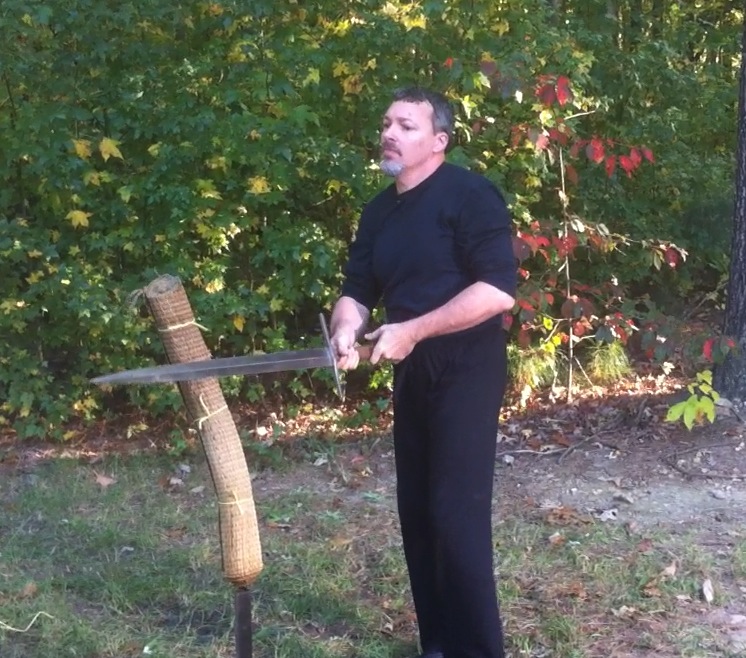 What
I hope comes across from consulting for PBS's Nova as a professional
historical fencing instructor and researcher, is my message
that, ultimately, swords cannot be evaluated just on the basis
of their cutting ability or edge sharpness. Real fighting
swords, even dedicated cutting blades, have to be able not
only to strike, but to ward off blows. They have to be resilient
and robust enough to take hits without bending or breaking
and be able to agilely set aside, displace, knock away or
send off strikes. This is a major part of the very reasons
the designs they were formed into, and
the materials they were made out of, each evolved over
time. Without this concern for the defensive function of swords,
just considering how well they cut on static targets misses
half of the matter. After all, swords were meant to be used
with force in violent combat and this cannot
be forgotten. What
I hope comes across from consulting for PBS's Nova as a professional
historical fencing instructor and researcher, is my message
that, ultimately, swords cannot be evaluated just on the basis
of their cutting ability or edge sharpness. Real fighting
swords, even dedicated cutting blades, have to be able not
only to strike, but to ward off blows. They have to be resilient
and robust enough to take hits without bending or breaking
and be able to agilely set aside, displace, knock away or
send off strikes. This is a major part of the very reasons
the designs they were formed into, and
the materials they were made out of, each evolved over
time. Without this concern for the defensive function of swords,
just considering how well they cut on static targets misses
half of the matter. After all, swords were meant to be used
with force in violent combat and this cannot
be forgotten.
Secrets of the Viking Swords, airing on PBS stations in the USA, October 2012, will also feature commentary
from metallurgists, sword researchers, a
swordsmith, and Polish reenactors of
Viking combat.
|
|

